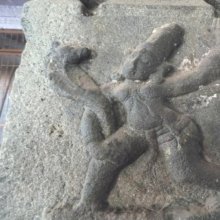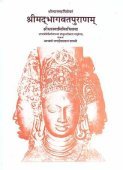Aghasura, Aghāsura, Agha-asura: 7 definitions
Introduction:
Aghasura means something in Hinduism, Sanskrit. If you want to know the exact meaning, history, etymology or English translation of this term then check out the descriptions on this page. Add your comment or reference to a book if you want to contribute to this summary article.
Images (photo gallery)
In Hinduism
Shilpashastra (iconography)
Source: Archaeological Survey of India: Śaiva monuments at Paṭṭadakal (śilpa)Aghāsura (अघासुर) is depicted as a sculpture on the second pillar of the southern half of the maṇḍapa of the temple of Lokeśvara.—Next to the Pralaṃbāsura is the scene of slaying Aghāsura. On seeing Balarāma and Kṛṣṇa, the demon Agha thought that the time had come for him to avenge the death of his sister Pūtanā and his brother Baka (as it is not shown in the bas-relief, we have not dealt with it here).
It is not very easy to show this story on stone. So the artist has demonstrated his talents by showing the demon knocked down by Kṛṣṇa. By controlling the demon with his left hand so that he will not have any chance to escape, Kṛṣṇa is raining good blows on the head with the right hand. A female figure is shown standing next to the demon with folded hands. May be it is one of the Gopī or Kṛṣṇa’s mother, dumb founded at the astonishing exploits of her supernatural child. Behind him is standing Balarāma with his hala.

Shilpashastra (शिल्पशास्त्र, śilpaśāstra) represents the ancient Indian science (shastra) of creative arts (shilpa) such as sculpture, iconography and painting. Closely related to Vastushastra (architecture), they often share the same literature.
Vaishnavism (Vaishava dharma)
Source: Pure Bhakti: Brhad BhagavatamrtamAghāsura (अघासुर) refers to:—A mystic demon who assumed the form of a large serpent and swallowed Kṛṣṇa and his cowherd boy friends, but was killed by Kṛṣṇa. He was the younger brother of the demons Pūtanā and Bakāsura. (cf. Glossary page from Śrī Bṛhad-bhāgavatāmṛta).

Vaishnava (वैष्णव, vaiṣṇava) or vaishnavism (vaiṣṇavism) represents a tradition of Hinduism worshipping Vishnu as the supreme Lord. Similar to the Shaktism and Shaivism traditions, Vaishnavism also developed as an individual movement, famous for its exposition of the dashavatara (‘ten avatars of Vishnu’).
General definition (in Hinduism)
Source: Wisdom Library: HinduismAghāsura (अघासुर, “boa-constrictor demon”) is the Sanskrit name of a demon (asura) sent by Kaṃsa (Kṛṣṇa’s maternal uncle) to kill Kṛṣṇa. These efforts did not succeed.
Languages of India and abroad
Sanskrit dictionary
Source: DDSA: The practical Sanskrit-English dictionaryAghāsura (अघासुर).—See अघ (agha) above.
Derivable forms: aghāsuraḥ (अघासुरः).
Aghāsura is a Sanskrit compound consisting of the terms agha and asura (असुर).
Source: Cologne Digital Sanskrit Dictionaries: Monier-Williams Sanskrit-English DictionaryAghāsura (अघासुर):—[from agha > agh] m. Agha, Kaṃsa’s general, [Bhāgavata-purāṇa]
[Sanskrit to German]
Sanskrit, also spelled संस्कृतम् (saṃskṛtam), is an ancient language of India commonly seen as the grandmother of the Indo-European language family (even English!). Closely allied with Prakrit and Pali, Sanskrit is more exhaustive in both grammar and terms and has the most extensive collection of literature in the world, greatly surpassing its sister-languages Greek and Latin.
See also (Relevant definitions)
Relevant text
Search found 16 books and stories containing Aghasura, Aghāsura, Agha-asura; (plurals include: Aghasuras, Aghāsuras, asuras). You can also click to the full overview containing English textual excerpts. Below are direct links for the most relevant articles:
Garga Samhita (English) (by Danavir Goswami)
Verse 2.6.15 < [Chapter 6 - The Liberation of Aghāsura]
Verse 1.6.45 < [Chapter 6 - Description of Kaṃsa’s Strength]
Verse 2.6.22 < [Chapter 6 - The Liberation of Aghāsura]
Chaitanya Bhagavata (by Bhumipati Dāsa)
Verse 2.1.338 < [Chapter 1 - The Beginning of the Lord’s Manifestation and His Instructions on Kṛṣṇa-saṅkīrtana]
Verse 2.1.161 < [Chapter 1 - The Beginning of the Lord’s Manifestation and His Instructions on Kṛṣṇa-saṅkīrtana]
Verse 1.9.30 < [Chapter 9 - Nityānanda’s Childhood Pastimes and Travels to Holy Places]
The Bhagavata Purana (by G. V. Tagare)
Chapter 12 - Slaying of Aghāsura < [Book 10 - Tenth Skandha]
Chapter 1 - Nārada Meets Bhakti (Devotion in a Human Form) < [Bhāgavata-Māhātmya: The Glory of Bhāgavata Purāṇa]
Chapter 31 - Gopīs’ song (prayer for Kṛṣṇa’s return) < [Book 10 - Tenth Skandha]
Vasudevavijaya of Vasudeva (Study) (by Sajitha. A)
Deviations from the Source Śrimad Bhāgavata < [Chapter 2 - Vāsudevavijaya—Authorship and Content Analysis]
Bhakti-rasamrta-sindhu (by Śrīla Rūpa Gosvāmī)
Verse 2.3.72 < [Part 3 - Involuntary Ecstatic Expressions (sattvika-bhāva)]
Verse 2.3.26 < [Part 3 - Involuntary Ecstatic Expressions (sattvika-bhāva)]
Verse 2.1.1 < [Part 1 - Ecstatic Excitants (vibhāva)]
Brihad Bhagavatamrita (commentary) (by Śrī Śrīmad Bhaktivedānta Nārāyana Gosvāmī Mahārāja)
Verse 2.2.200 < [Chapter 2 - Jñāna (knowledge)]
Verse 1.5.29 < [Chapter 5 - Priya (the beloved devotees)]
Verse 2.4.164 < [Chapter 4 - Vaikuṇṭha (the spiritual world)]
Related products

